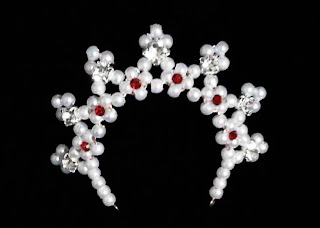The Noble Family of Jennings have held the title of Dukes of Marlboro for several hundred years. As such they have accumulated wealth, prestige and a great collection of historic furniture, art and jewellery. They also own a castle and some other properties and businesses. They were however greatly affected by the 96 revolution but at least the family jewels remained in tact and resides with the current Duke in the Republic of Canadium. Today we will discuss the traditional collection and see where it finds itself at present.
The 9th Dowager of Marlboro, Lady Renalda Jennings wears the Marlboro Tiara to the wedding of Queen Crystobel of Scotney and the Crown Prince of Britania.
A detailed photo of the ancestral tiara of the Marlboro family. It is reported to have been made in the late 1800's for the then Duchess to be as a betrothal gift. Many families will sometimes alter older jewels in order to modernise the design, this one stayed in tact and survived the revolution.
The current Duke of Marlboro accompanies his sister, Lady Loelia Jennings, who wears the tiara to the gathering in 2011 where the official Royal and Noble Family photo was taken. The Marlboro collection also includes several earrings and necklaces set with diamonds like that in the photo.
Pink Topaz is also sometimes called Imperial Topaz. This pink tiara is called the Renalda Tiara and was made for the 9th Duchess as a 10th wedding anniversary. Lady Loelia wears matching earrings which is part of a demi-parure that includes a necklace. The demi-parure was acquired in the 1980's to compliment the tiara.
This photo shows the detail of the tiara.
Another part of the Marlboro collection has been inherited by the current Duke's brother. Lord Michael Jennings married the Infanta Isabella of Hispania. Upon marriage he was created the Duke of Toledo and his name was changed to the Hispanic Miguel. His marriage entitled him to some of the Marlboro Family jewels for his new wife.
The Marlboro Platinum and Aquamarine Parure. This rather modern set of jewellery was made for the 10th Duke's wife in the 1980's especially for the wedding of the Queen of Scotney and the Crown Prince of Britania.
The elegant beauty of the Aquamarine Parure can be appreciated in this archive photo.
The Marlboro Platinum and Aquamarine Parure. This rather modern set of jewellery was made for the 10th Duke's wife in the 1980's especially for the wedding of the Queen of Scotney and the Crown Prince of Britania.
The elegant beauty of the Aquamarine Parure can be appreciated in this archive photo.
Infanta Isabella, seen in pink in the centre, wears the Aquamarines to the 2010 Christmas Ball.
Depending on the Family tradition, the Aquamarines might return to the Marlboros upon the death of Infanta Isabella or they may remain as an inheritance for her descendants. We will have to wait and see and in the mean time enjoy whenever these amazing jewels are worn. Look out for them at the next major event.





































